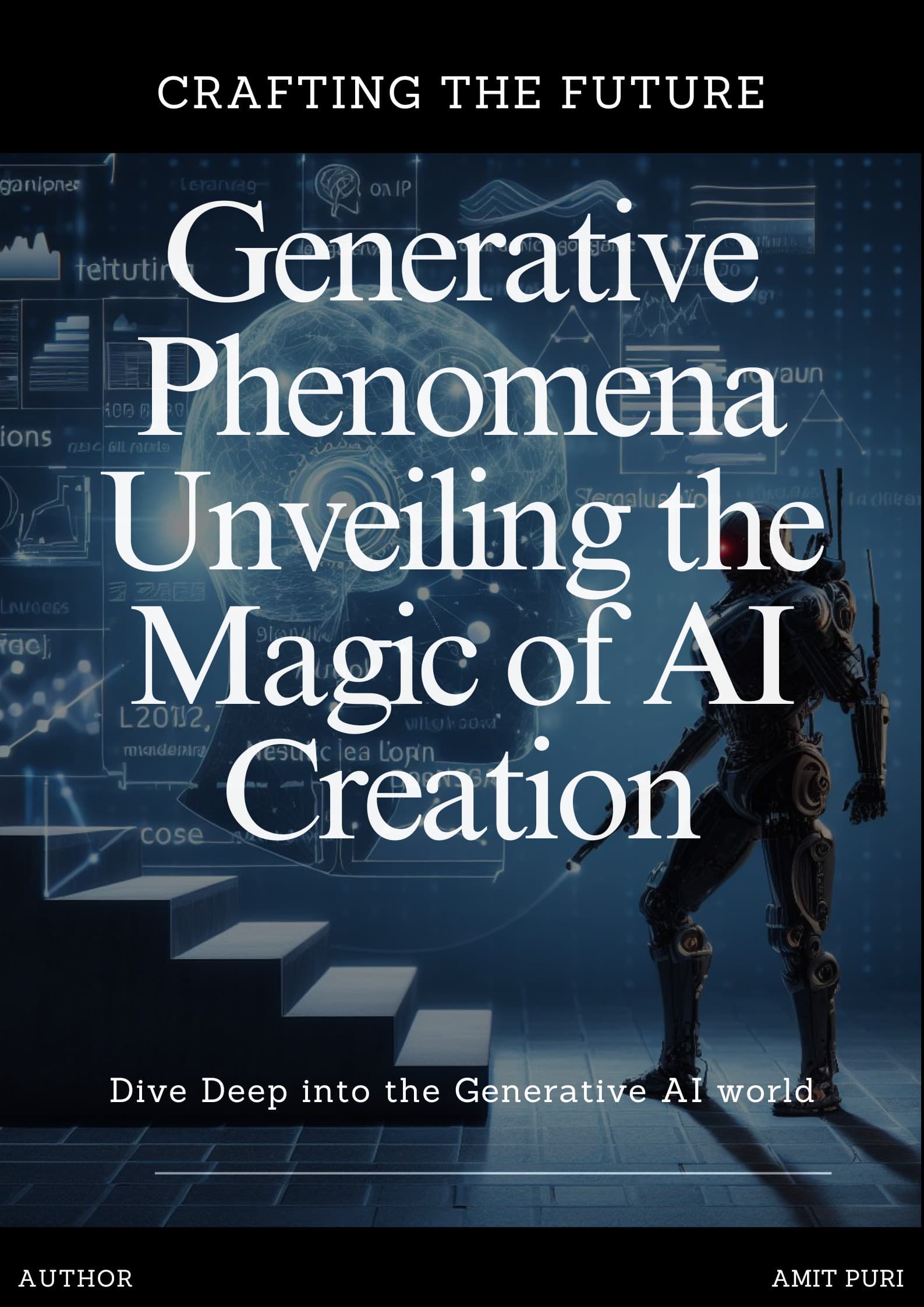10 min to read
Early Preview: Book outline - Generative Phenomena Unveiling the Magic of AI Creation
Crafting the Future: A Guide to Generative AI Techniques and Applications

Early Preview - Book outline - Generative Phenomena Unveiling the Magic of AI Creation
Dive into a realm where the boundaries of reality and imagination blur, where machines don’t just compute—they create. Imagine an AI that can paint a masterpiece, compose a symphony, or even craft a story that resonates with human emotion. Welcome to the world of Generative AI, a frontier of technology that’s redefining the very essence of creativity. As you embark on this journey, prepare to be both awed and challenged, for you’re about to explore a domain where machines dream, design, and even dare to innovate. Whether you’re a tech enthusiast, an artist, or simply a curious soul, this exploration promises a roller-coaster of wonder, debate, and inspiration. Are you ready to witness the future of creation?
In the vast and ever-evolving landscape of artificial intelligence, one domain has captured imaginations and sparked both wonder and debate: Generative AI. At its core, generative AI is about creation. It’s about machines not just learning from data but using that knowledge to generate new, previously unseen content, be it an image, a piece of music, or a block of text.
The concept of machines creating content might seem like science fiction, but it’s a reality we’re living today. From art installations crafted by algorithms to news articles penned by bots, the manifestations of generative AI are all around us. But what exactly is it, and how does it work?
Generative AI operates on the principle of understanding patterns within data and then replicating or extrapolating those patterns to produce new content. It’s akin to teaching a machine the essence of a rose and then asking it to paint a garden. The machine doesn’t just replicate roses it has seen; it creates a myriad of roses, each unique, drawing from its understanding of the flower’s essence.
Two primary models have dominated the generative AI space: Generative Adversarial Networks (GANs) and Variational Autoencoders (VAEs). GANs, for instance, operate on a fascinating principle of competition between two networks, the generator and the discriminator. The generator creates content, and the discriminator evaluates it. Through this iterative process, the generator gets better and better, producing increasingly convincing content.
But generative AI isn’t just about creating convincing replicas. It’s about innovation. It’s about machines offering solutions, designs, or ideas that we humans might not have thought of. It’s about augmenting human creativity, not replacing it.
However, with great power comes great responsibility. The capabilities of generative AI have raised ethical concerns, especially in areas like deepfakes, where the line between reality and fabrication blurs. As we delve deeper into this book, we’ll explore not just the wonders of generative AI but also its challenges, its implications, and its future.
Join us on this journey into the world of Generative AI, where we’ll demystify the magic behind the machine and explore the infinite possibilities it holds.
Book Outline- Generative Phenomena Unveiling the Magic of AI Creation
Chapter 01 - Buzz around Generative AI
In recent years, the tech world has been abuzz with talk of Generative AI, and for good reason. This groundbreaking domain of artificial intelligence has transcended traditional boundaries, offering glimpses into a future where machines don’t just analyze or predict, but actively create. From generating hyper-realistic images to composing music tracks, and even crafting narratives, Generative AI has become the poster child for the next wave of AI innovation. Its applications, both mesmerizing and controversial, have graced headlines, stirred debates in academic halls, and captured the imagination of entrepreneurs and artists alike. As stories of AI-created artworks selling for hefty sums at auctions or deepfake videos blurring the lines of reality circulate, the buzz only intensifies. Everyone, it seems, wants to understand, harness, or simply marvel at the potential of this transformative technology.
Chapter 02 - Foundation and Generative models Overview
At the heart of Generative AI lies a rich tapestry of foundational concepts that give it both depth and versatility. Starting with the bedrock of Probability and Statistics, it’s essential to grasp how data distributions and statistical inferences play pivotal roles in the generation process. Building upon this, the realm of Machine Learning offers the tools and techniques that enable systems to learn from data, setting the stage for more advanced generative tasks. Delving deeper, Neural Networks and Deep Learning provide the architectural backbone, empowering AI models to handle vast amounts of data and extract intricate patterns. As we transition to Basic Generative Models, the Gaussian Mixture Models (GMM) emerge as powerful tools for data clustering and representation. Hidden Markov Models (HMM), with their ability to predict sequences, find applications in areas like speech recognition. Lastly, the Naive Bayes Generative Models stand as testament to the power of simplicity, leveraging basic probability theories to classify and generate data. Together, these foundational elements weave the intricate fabric of Generative AI, setting the stage for a world of creative possibilities.
Chapter 03 - The Evolution of Generative Models
The journey into the world of Generative AI begins with Basic Generative Models. Here, Gaussian Mixture Models (GMM) stand out as statistical tools adept at modeling data distributions, often used in clustering tasks. Hidden Markov Models (HMM), with their sequential nature, have been instrumental in areas like speech and handwriting recognition. Meanwhile, Naive Bayes Generative Models simplify complex datasets, using basic probability to make predictions. As we venture deeper, Deep Generative Models emerge, pushing the boundaries of what’s possible. Variational Autoencoders (VAEs) offer a probabilistic approach to encoding and decoding data, making them invaluable in tasks like image generation. Generative Adversarial Networks (GANs), perhaps the most celebrated of the lot, operate on a dueling network principle, leading to astonishingly realistic creations. Restricted Boltzmann Machines (RBMs), though older, have paved the way for deep learning’s rise, especially in collaborative filtering. Advancing further, we encounter Advanced Generative Techniques. Here, Conditional GANs allow for targeted content generation, CycleGANs enable remarkable domain adaptations without paired data, and Transformer-based Generative Models harness attention mechanisms to produce coherent and contextually relevant outputs. Together, these models and techniques represent the cutting edge of AI’s creative potential, each layer adding depth and nuance to the generative process.
Chapter 04 - Applications of Generative AI: Unleashing Creative Potential
Generative AI has ushered in a renaissance of digital creativity, finding applications across diverse domains. In the realm of Image Generation and Manipulation, AI not only crafts hyper-realistic images from scratch but also enhances, modifies, and restores existing ones, revolutionizing fields from art to medical imaging. When it comes to Text Generation, AI models weave narratives, pen poetry, and even draft articles, blurring the lines between human and machine authorship. The world of sound hasn’t remained untouched either; Music and Sound Generation through AI has led to the composition of novel melodies, soundscapes, and even entire albums, challenging traditional notions of musical creativity. Lastly, the dynamic sphere of Video and Animation Generation sees AI creating lifelike animations, simulating realistic scenes, and even generating short films. These applications, while just the tip of the iceberg, highlight the transformative power of Generative AI, reshaping industries and redefining the boundaries of digital artistry.
Chapter 05 - Challenges and Limitations of Generative AI: Navigating the Complex Landscape
While the promise of Generative AI is undeniably vast, it is not without its challenges and limitations. A notable concern in the realm of Generative Adversarial Networks (GANs) is Mode Collapse, where the model converges to generating limited or identical outputs, stifling diversity and creativity. Then there’s the perennial challenge of Overfitting and Generalization. As powerful as these models are, they can sometimes become too attuned to their training data, failing to produce generalized results or falling prey to reproducing noise. Beyond the technical hurdles, Ethical Considerations loom large. The ability of AI to generate realistic content, be it images, videos, or text, raises concerns about misinformation, deepfakes, and the potential misuse in malicious endeavors. Moreover, questions about authorship, rights, and the very essence of creativity emerge as AI begins to tread on traditionally human domains. As we harness the power of Generative AI, it’s imperative to navigate these challenges with caution, ensuring that the technology serves as a boon, not a bane, to society.
Chapter 06 - The Horizon of Generative AI: Charting the Uncharted
As we gaze into the future of Generative AI, a panorama of possibilities unfolds. At the forefront are Emerging Trends and Research Areas, with scientists and researchers pushing the boundaries of what’s conceivable, exploring novel architectures, and refining algorithms to achieve unprecedented levels of realism and creativity. Concurrently, the Integration with Other AI Domains is set to amplify the potential of generative models. By synergizing with fields like reinforcement learning, robotics, or natural language processing, Generative AI promises applications that are more holistic, adaptive, and contextually aware. However, as the technology advances, the Societal Impacts and Considerations become paramount. The democratization of AI-generated content, while empowering, also necessitates a reevaluation of issues like privacy, authenticity, and the potential for misinformation. Moreover, as AI begins to influence art, entertainment, and media, society will grapple with philosophical questions about creativity, authenticity, and the human touch in a digitally generated world. The future of Generative AI, thus, is not just about technological advancements but also about navigating the intricate interplay between innovation, ethics, and societal values.
Chapter 07 - Practical Implementations of Generative AI: From Blueprint to Mastery
Embarking on the practical journey of Generative AI requires a meticulous approach. It begins with Setting Up the Environment. This encompasses not just the technical infrastructure but also acquiring the right skillset. A deep understanding of neural architectures, proficiency in frameworks like TensorFlow or PyTorch, and familiarity with relevant APIs are essential building blocks. As one delves deeper, the world of Advanced Applications and Case Studies offers a treasure trove of insights. From AI-generated artworks selling in renowned galleries to real-world solutions in industries like healthcare, fashion, or entertainment, these case studies serve as both inspiration and a testament to the technology’s transformative power. However, true mastery in Generative AI isn’t just about implementation; it’s about refinement and evolution, a journey of Leading to Maturity. This involves continuous learning, iterating on models, addressing challenges, and staying abreast of the ever-evolving landscape of AI research and applications. In essence, practical implementation is a dynamic blend of technical prowess, real-world application, and the relentless pursuit of excellence.
Chapter 08 - Crafting a Real-time Case Study and Navigating the Knowledge Ocean
Diving into the practicalities of Generative AI often culminates in Building a Real-time Case Study. Such hands-on projects not only solidify understanding but also showcase the tangible impact of generative models in real-world scenarios. Whether it’s creating a virtual fashion assistant or simulating urban planning scenarios, these case studies serve as invaluable benchmarks for aspiring AI enthusiasts. However, the journey doesn’t end there. The field is vast, and continuous learning is paramount. Books and Papers offer deep dives into the intricacies of algorithms, methodologies, and the theoretical underpinnings of the domain. For those who prefer a structured learning path, Online Courses and Tutorials provide guided instruction, often with interactive components and peer feedback. Yet, the learning ecosystem of Generative AI isn’t complete without the vibrant Communities and Forums. These platforms foster collaboration, facilitate knowledge exchange, and provide avenues for troubleshooting and innovation. Together, hands-on projects and a plethora of resources form the roadmap for anyone aspiring to master the captivating world of Generative AI.
Acknowledgements

Work in progress

| Read about First Chapter |
|---|
Go back to chapters listing on Book - Generative Phenomena Unveiling the Magic of AI Creation
If you are interested in Citizen Development, refer to this book outline here on A Guide to Citizen Development in Microsoft 365 with Power Platform
| Now, available on | ||||
|---|---|---|---|---|
|
|
||||

|
||||
|
|
|
|
|
|
If you wish to delve into GenAI, read Enter the world of Generative AI
Also, you can look at this blog post series from various sources.
Stay tuned! on Generative AI Blog Series

Comments